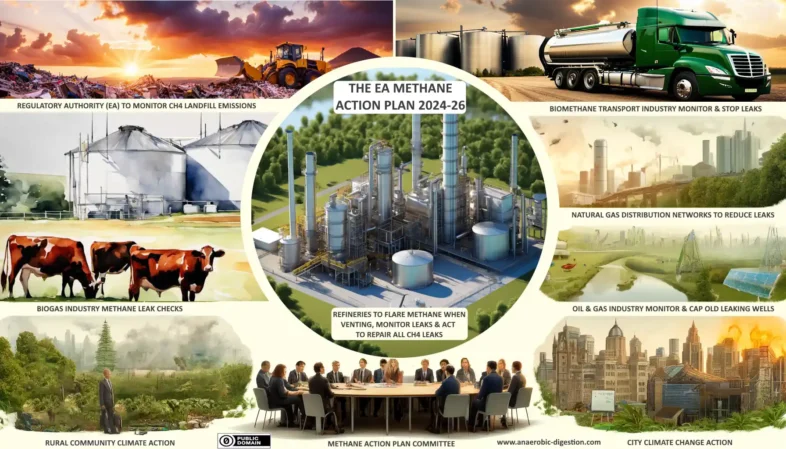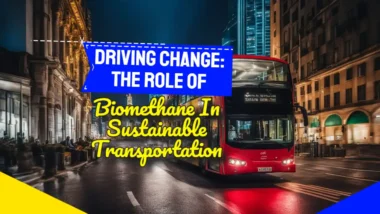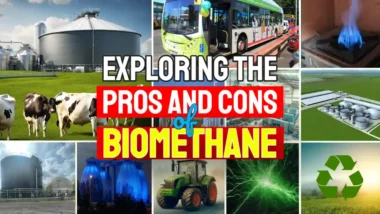Worried about the impact of methane on our planet? If so, this article will interest you because we have news for you that the UK Methane Action Plan 2024–2026 is a start at taking action. Methane emissions are a big problem, contributing to global warming. Methane emissions are much lower than CO2, but a lot more damaging per tonne to global warming. This article will outline how the UK's Methane Action Plan for 2024–2026 aims to tackle this issue.
Read on for key insights.
Key Takeaways
- The UK's EA Methane Action Plan from 2024 to 2026 aims to cut methane emissions, helping meet climate goals and a net-zero target by 2050. It focuses on improving data quality, making regulations stronger, and building partnerships.
- Methane is a strong greenhouse gas, with the UK committing to the Global Methane Pledge to reduce methane emissions by at least 30% by 2030. Actions include Leak Detection and Repair (LDAR) in industries and Best Available Techniques (BAT) for cleaner technology use.
- Since 1990, the UK has reduced its methane emissions by over 62%, showing big efforts across farming, waste management, and energy sectors. Key strategies involve tighter controls through Environmental Permitting Regulations (EPR) and considering changes to include methane in the UK Emissions Trading Scheme (ETS).
- Partnerships with industry experts, governments worldwide, health agencies, and academic circles are crucial for sharing knowledge on reducing methane releases effectively. This collaborative approach supports global commitments like COP28 and the Paris Agreement.
- Efforts will focus on areas like agriculture, where nearly half of the UK's methane emissions originate. Innovations such as transforming animal waste into energy exemplify practical ways to achieve reductions while also engaging in smarter waste management practices.
We refer to the EA's plan as the UK Methane Action Plan because a lot of people are searching for this term and the EA's plan is the closest to a national UK plan although this is a devolved matter and each nation will no doubt independently work to their own plans.
The Environment Agency's Methane Action Plan 2024-2026 for England
The Environment Agency has a plan to tackle methane, a major greenhouse gas. From 2024 to 2026, they aim to cut down what the UK sends into the air, keeping climate goals on track.
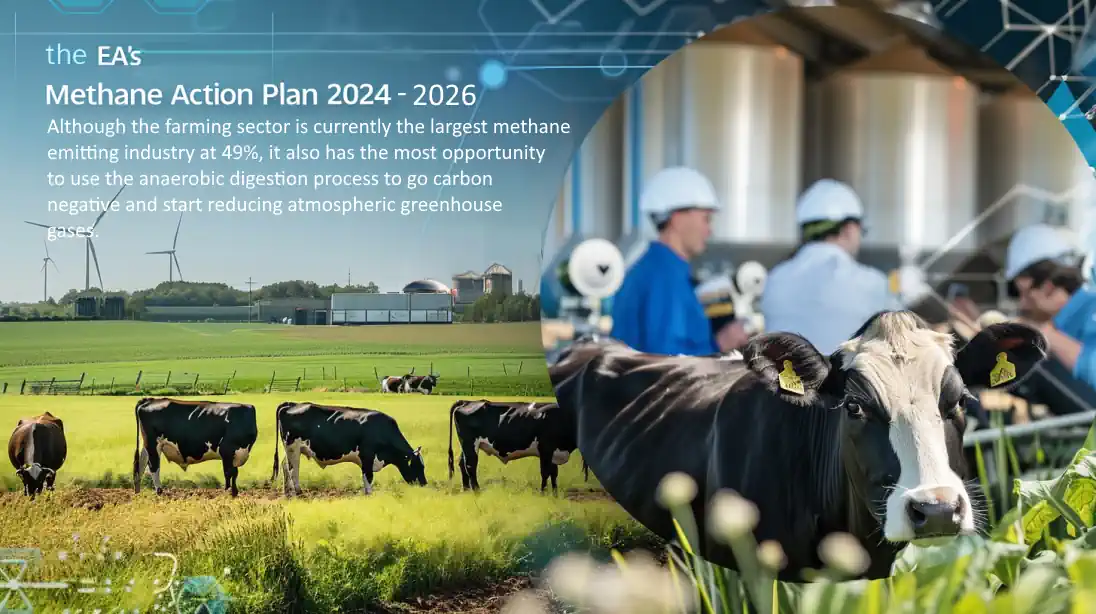
Objectives of the plan
The UK's Methane Action Plan aims for three key goals. First, it seeks to enhance data quality on methane emissions. This means getting better information on where and how much methane we release into the air.
Second, this plan strives to make existing methane leakage prevention rules stronger so that reducing methane becomes a must-do for:
- biogas plant businesses,
- gas grid companies,
- non-renewable oil and gas refineries
- biomethane transport and use,
especially those handling waste or using old equipment.
This includes checking gas systems at rubbish dumps more closely and making sure new permits push for the best technology to be bought and used to cut down emissions.
Thirdly, the plan encourages working together with others outside the government. Businesses, scientists, and other countries all have a part to play in tackling methane leaks. To do this well, strategies like leak detection and repair (LDAR) will target industries known for high emissions, ensuring they find and fix leaks quickly.
By focusing on these objectives—improving how we track emissions, making laws tougher but fairer, and building strong partnerships—the UK aims to play a big part in the global effort against climate change while moving towards net zero by 2050.

Commitment to reaching net zero emissions by 2050
Moving from objectives, the UK has set a firm goal. By 2050, all net emissions will be zero. This means a stop to adding greenhouse gases to the air more than we take out. It's part of a bigger promise, the Global Methane Pledge.
This is where countries agree to lower methane gas by 30% by 2030 compared to levels in 2020.
Methane makes up 14% of the UK’s total greenhouse gases right now. Since 1990, methane emissions have dropped over 62%. Reaching net zero by 2050 is tough but necessary. To meet this goal, every bit counts, from cutting down on waste to changing how we use energy and technology.
Global Methane Pledge
The UK has joined the Global Methane Pledge, aiming to cut methane gas releases by at least 30% by 2030. This promise covers emissions from rubbish tips, farming, and fossil fuel activities.
It's a big step because methane warms the Earth much more than CO2 over a short time. Cutting down methane quickly reduces warming and improves air quality more quickly than doing anything else.
I've witnessed industries taking steps to find and fix leaks in pipes and equipment. They use special cameras to see the gas that we can't see with our eyes and generally stop leaks through maintenance. In fact, this has proven to be an excellent value when you consider the income lost from the lost gas.
Also, UK farmers are trying new ways to feed cows so they produce less methane.
These actions show how serious the UK is about this global pledge.
Methane Emissions in the UK
Methane leaks in the UK, perhaps slightly less than in nations that until now have not required all landfills to be fitted with landfill gas collection and flaring equipment. But what is emitted adds to warming the planet. It comes from waste, animals (especially ruminants like beef cattle and cows), and leakage such as from gas mains.

Contribution to climate change
Methane has a big impact on global climate change. It traps heat in the atmosphere far more effectively than CO2, making it a much stronger greenhouse gas at about 80 times more damaging over the short term. In 2022, this gas accounted for 14% of all the UK's greenhouse gases.
Sectors like farming, rubbish handling (waste management), and natural gas fuel supply pipe leaks, pushed out most of these emissions—49%, 30%, and 8%, respectively.
Since 1990, the UK has reduced methane releases by over 62%. This drop shows successful efforts to manage and reduce how much goes into the air. Yet, methane still plays a major role in heating up our planet.
Actions to lessen its release are key in fighting climate warming.
Percentage of total UK greenhouse gas emissions
Methane made up 14% of the UK’s total greenhouse gases in 2022. Different activities like farming, waste handling, and fuel supply were major sources. Farming alone was almost half of this, at 49%.
Waste added another 30%, and fuel supply was about 8%. Since 1990, the UK has cut its methane (CH4) release by over 62%. This shows that big steps in tackling climate change can be taken and the targeted reductions can be achieved. The local council waste management officers across all of England are working hard to bring these numbers down even more by focusing on where methane pipe leakage monitoring data comes from and using it effectively to find and repair leaks.
Reported decrease in emissions since 1990
Moving from the bigger picture of greenhouse gases, UK methane emissions have seen a significant drop. Since 1990, these emissions have fallen by over 62%. This fact shows clear progress in tackling one of climate change's big challenges.
I've seen firsthand how changes in agricultural practices and waste management have made a real difference. Farms are using more efficient ways to deal with animal waste, turning it into energy instead of letting it release methane into the air.
Landfills now capture gas for power generation, cutting down on what used to just escape into the atmosphere.
This push has led sectors like agriculture, waste, and energy supply to cut their methane output considerably since the early '90s. Agriculture alone has transformed its methods to be less methane-heavy.
With everyone from farmers to city planners playing a part, it's clear why we're seeing such impressive numbers today—49% comes from farming activities, while landfills and natural gas supply contribute 30% and 8%, respectively.
Together, they paint a hopeful picture of our fight against climate change.
New infographic offered (below): AI images used – (C) copyright-free CC0 image can be used online by all of you
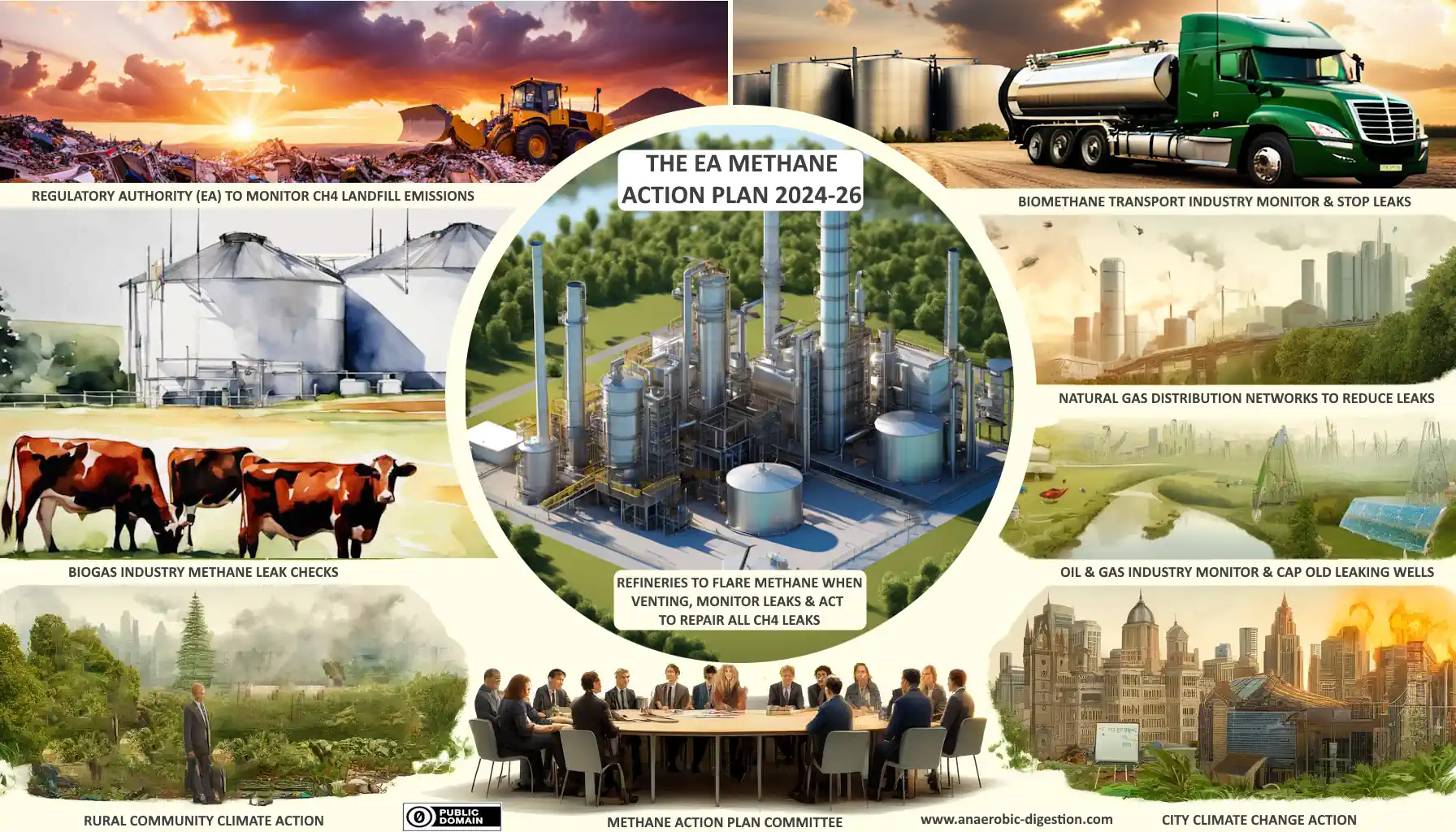
The Three Main Objectives of the UK Methane Action Plan
The Methane Action Plan aims to better understand methane leaks, make rules more effective, and work closely with other groups. These goals guide action to cut down on a powerful bad air substance from the UK's environment.
Check this out for steps on tackling climate issues with smart strategies and teamwork.
Improving data
To better grasp methane's impact, the UK Environment Agency is upping its game in data collection and analysis. They're putting together a national database to hold all things emission-related.
This isn't just about gathering numbers; it’s about updating how we measure emissions from different sources, like landfills or oil fields, making sure everything is accurate and reliable.
I've seen firsthand how tricky it can be to track methane leaks from agriculture or waste management. With improved methods — think leak detection tech and revising emission factors — we’re getting clearer pictures of where cuts can happen.
It’s straightforward: better data leads to sharper strategies for cutting down methane's role in climate change.
Maximising the effectiveness of regulation
Regulations need fixing to work well. The UK is doing just that for methane, cutting down leaks and waste. They check reports from places that break down waste without oxygen and fix them.
This makes sure they follow the best methods available. They also give new permits with strict rules. This pushes everyone to do better in stopping methane leaks.
Landfills are getting a closer look too, aiming for top-notch gas management systems. By doing this, the UK ensures less methane escapes into the air. Each step—checking reports, updating permits, reviewing landfills—aims to cut methane emissions sharply by 2024 to 2026.
Working with external partners
After tightening rules, the plan shifts focus to teaming up with others outside. This means joining forces with groups like governments, health bodies, and schools. They all help in finding ways to cut down on methane gas.
This partnership is key for sharing smart ideas and tools for tackling this issue.
Groups from different fields come together—like those working on farm waste or new energy types—to lower methane release. They use voluntary schemes to make a big impact without strict rules.
These efforts aim at hitting net zero emissions by 2050 and following the global promise on methane reduction.
UK Methane Action Plan Initiatives and Strategies
The UK is stepping up. They're launching cool plans to cut down on methane—a bad gas for our air. They'll find leaks and fix them, use the best ways to stop methane from getting out, talk with people who know a lot, and work with other countries.
Smart moves for better air and a happier planet!

Leak Detection and Repair (LDAR)
LDAR focuses on finding and fixing leaks from pipes and equipments in industries that release methane. This process involves using special tools like infrared cameras to spot where the gas is escaping.
Once found, the leaks are quickly repaired to stop methane from going into the air. Think of it as a big game of hide-and-seek, but instead of finding people, we're spotting invisible gas leaks.
I've seen teams work with these infrared cameras first-hand. They scan large areas of equipment swiftly, making sure nothing slips by unnoticed. It's surprising how effective this method is at reducing emissions.
In fact, rolling out LDAR to high-priority sectors shows our commitment to cutting down methane slip—from storage spots, engines, and stacks where gases are processed or upgraded.
It's an important part of the UK Methane Action Plan because LDAR can make a big difference quickly.
Best Available Techniques (BAT)
Moving from leak detection and repair, let's talk about Best Available Techniques (BAT). These are top methods to stop or limit bad stuff getting into our air and water. The UK has rules for BAT in England.
They make sure industries do their best to keep the environment clean. For example, in a factory that makes paint, BAT might mean using special filters that catch harmful chemicals before they escape into the air.
I've seen BAT in action at a local recycling plant. They used new machines that sort waste better and faster, cutting down on what goes to landfills. This isn't just good for the air and rivers; it saves money too because less trash means lower landfill taxes.
So, following these techniques isn't just about following laws; it's smart business too.
Engagement with industry and academia
Working with companies and schools is a big part of the UK Methane Action Plan to cut down methane gas. This effort includes teaming up with those who make machines that turn waste into energy and groups that study how to use less methane on farms.
They find smart ways to capture methane from cattle farms and change it into hydrogen at energy-making sites. This helps us all by making less methane go into the air.
The plan also involves talking and sharing ideas with many different experts like scientists, health advisors, and people from other countries. They join hands to come up with new methods and share what they know about stopping so much methane from getting out.
By doing this together, they can reach their goal of cutting down methane gas between 2024 and 2026. Sharing knowledge makes everyone smarter about how to deal with this challenge.
Collaboration with government and international partners
The UK's Methane Action Plan gets strength from partnerships with key global players. This includes governments, health agencies, academic circles, and non-profits worldwide. Together, they tackle methane leaks and aim for cleaner air.
These collaborations ensure the plan aligns with international efforts like the Global Methane Pledge.
This joint effort involves sharing best practices for detecting methane leaks and transforming them into energy. For example, farms capture methane to create power, while some plants change it into hydrogen fuel.
By doing this with partners across borders, the UK makes a stronger impact on reducing global emissions in line with commitments made under agreements such as COP28 and the Paris Agreement.
Regulation and Monitoring of Methane Emissions
Regulation and watching over methane leaks use rules like Environmental Permitting Regulations (EPR). They check on how much gas companies can release. This is part of a big effort to cut down on the harmful air that warms our planet.
So, keep reading if you're keen to learn more about how they're tackling this challenge!
Use of Environmental Permitting Regulations (EPR)
To control methane leaks, the UK relies on Environmental Permitting Regulations (EPR). Facilities must get a permit or prove they don't need one. This rule makes sure businesses limit their harmful gases.
The EPR sets clear limits for different pollutants through Emission Limit Values (ELVs). These limits are strict and legally binding.
I worked at a plant where we had to follow these rules closely. We measured our emissions often to make sure we stayed within the set boundaries. It was tough but needed to keep air clean.
Every business dealing with gases like methane must take this seriously to help stop climate change.
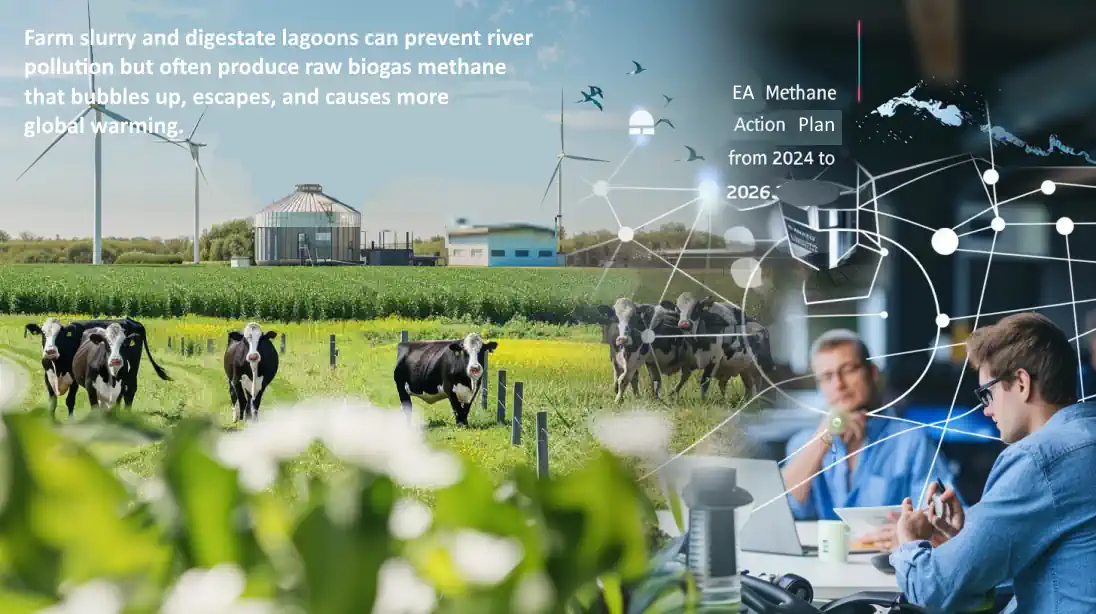
Involvement in the UK Emissions Trading Scheme (ETS)
The UK Emissions Trading Scheme (ETS) is setting its sights on methane, a potent greenhouse gas. Despite not covering methane right now, changes are coming. In 2022, the UK's leaders talked about making the ETS include methane from oil and gas industries above ground.
They're planning more talks to work out how to do this.
I've seen firsthand how these discussions can shape policies. For example, when working in environmental regulation, dialogue often leads to broadening schemes like the ETS to tackle emissions more effectively.
By bringing in methane emissions under the ETS umbrella, the aim is clear: cut down on what harms our climate most efficiently. This move shows a firm commitment toward slashing overall greenhouse gases—a key step towards meeting crucial net-zero targets by 2050.
Development of evidence for Emission Limit Values (ELVs)
To set Emission Limit Values (ELVs), experts look at emission factors from specific sources. They find these by measuring how much methane comes from places like landfills or farms.
This method helps make sure the limits are based on real data. Methane doesn't have a standard air quality limit now, but getting these values right could change that.
Right now, goals for limiting methane aren't strong in permits since there's no set target for ELVs. The plan is to use Best Available Techniques (BAT) more effectively. These techniques are top ways to lower emissions and protect the environment.
By focusing on these areas, the UK can create stronger rules for methane and help fight climate change better.
Conclusion
The UK Methane Action Plan 2024 to 2026 cuts methane emissions. It uses smart ways, like Leak Detection and Repair, to find leaks fast. The plan works with many groups for the best results.
This makes sure we all do our part in reducing pollution. By following this plan, we help stop climate change. Every step counts towards cleaner air for everyone. Let's make our future better by taking action today.
UK Methane Action Plan FAQs
1. What's the UK Methane Action Plan 2024 to 2026?
It's a plan, right? The UK aims to cut down methane emissions—this gas heats up our planet. They're doing it by following global agreements and making changes in how we deal with waste and use energy.
2. Why does methane matter?
Methane is super good at trapping heat—way better than CO2. It comes from rotting food, oil and gas stuff, and even cows! Cutting it down helps cool the Earth.
3. How will the UK reduce methane?
They've got ideas like using food waste for energy instead of letting it rot, stopping gas leaks in energy work, and saying no more to just burning off unwanted gas.
4. Can this plan really make a difference?
Yes! By tackling these emissions, the UK can help stop the world from getting too hot too fast. Plus, it shows other countries how to do their part.
5. What are anaerobic digestors?
These are cool machines that turn waste into power without needing oxygen. So instead of throwing away leftovers or certain trash, they get turned into something useful like electricity or heat.
6. Is there a bigger picture here?
Absolutely! This action isn't just about cutting one type of bad air; it's about changing how we think about all kinds of waste and energy—to keep our air clean and fight climate change all at once.
[/soc_panel]

